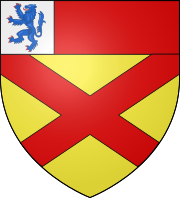Lord Elgin
| Earldom of Elgin | |
|---|---|
 
Or, a saltire and chief gules on a canton argent a lion rampant azure armed and langued of the second
|
|
| Creation date | 21 June 1633 |
| Monarch | Charles I |
| Peerage | Peerage of Scotland |
| First holder | Thomas Bruce, 3rd Lord Kinloss |
| Present holder | Andrew Bruce, 11th Earl of Elgin |
| Heir apparent | Charles Bruce, Lord Bruce |
| Remainder to | Heirs male forever, bearing the name Bruce |
| Subsidiary titles | Baron Elgin Lord Bruce of Kinloss Lord Bruce of Torry |
| Seat(s) | Broomhall House |
| Armorial motto | Fuimus ("We have been") |
Earl of Elgin /ˈɛlɡɪn/ is a title in the Peerage of Scotland, created in 1633 for Thomas Bruce, 3rd Lord Kinloss. He was later created Baron Bruce of Whorlton of York in the Peerage of England on 30 July 1641. The Earl of Elgin is the hereditary Clan Chief of Clan Bruce.
The family descended from the Bruces of Clackmannan, whose ancestor was Thomas de Bruys. According to Sir James Balfour Paul, there is no evidence that this branch of the family was related to Robert the Bruce (King Robert I), despite claims that Thomas was an illegitimate son of the king.
The first earl was succeeded by his son, Robert, who also was created Earl of Ailesbury in the Peerage of England. The two Earldoms continued united until the death of the fourth Earl of Elgin, when the Ailesbury and Baron Bruce of Whorlton titles became extinct, and the Elgin title passed to the Earl of Kincardine; the Lordship of Kinloss became dormant. Thereafter, the Earldoms of Elgin and Kincardine have remained united.
The most famous Earl was the 7th Earl, who removed and transported to Britain the so-called Elgin Marbles from the Parthenon. In Dublin there are roads that come from the Earl's titles. These are Elgin Road and Ailesbury Road.
As well as the titles Earl of Elgin and Earl of Kincardine, Lord Elgin also holds the titles Lord Bruce of Kinloss (created 1608), Lord Bruce of Torry (1647) and Baron Elgin, of Elgin in Scotland (1849). The first two are in the Peerage of Scotland; the third is in the Peerage of the United Kingdom.
...
Wikipedia
